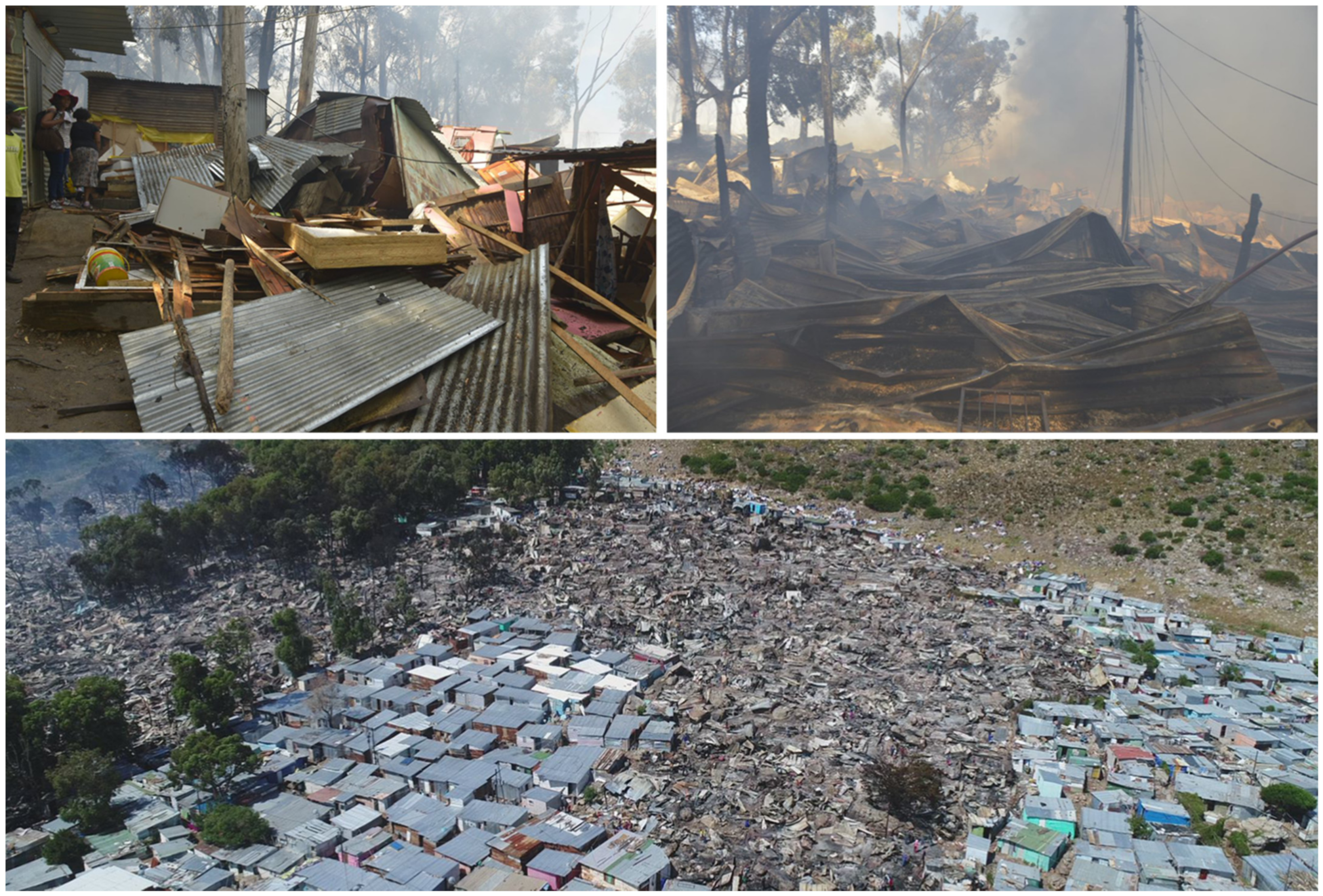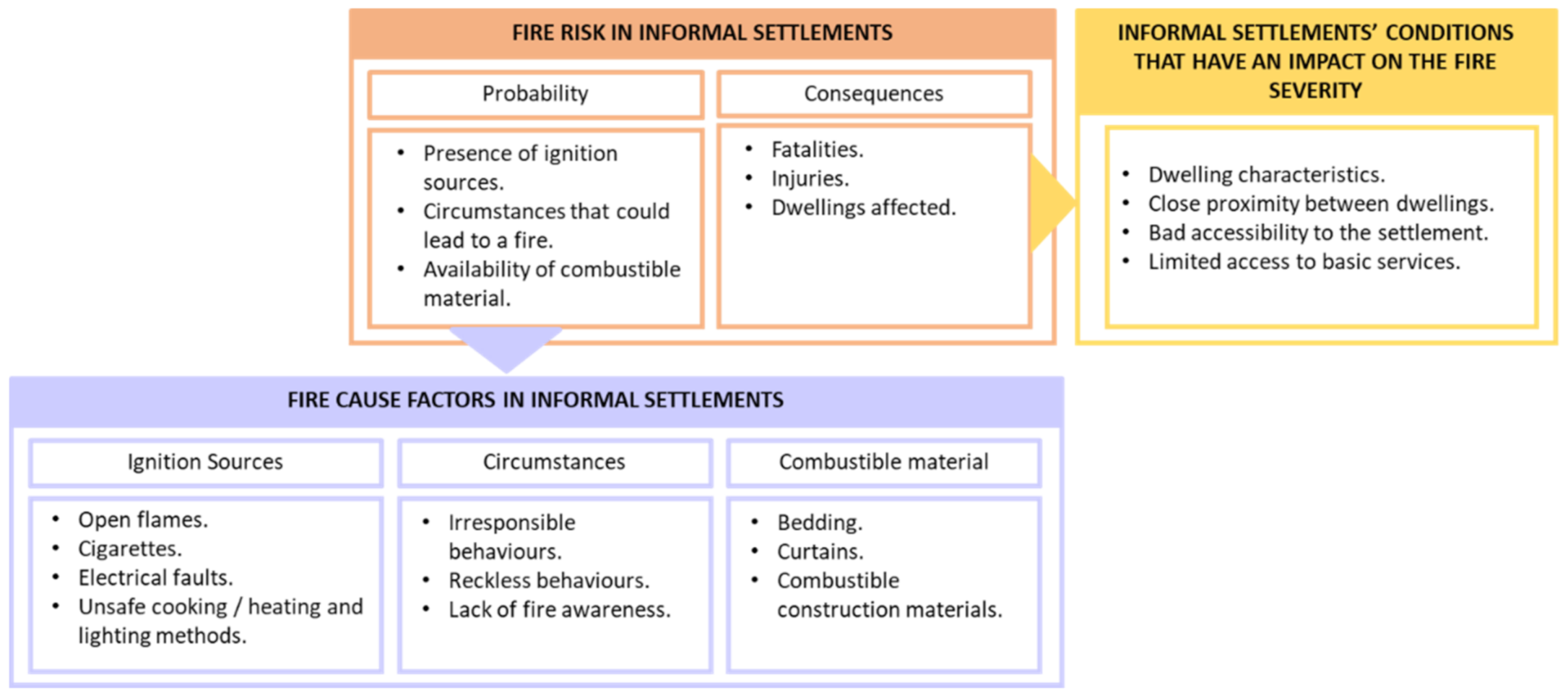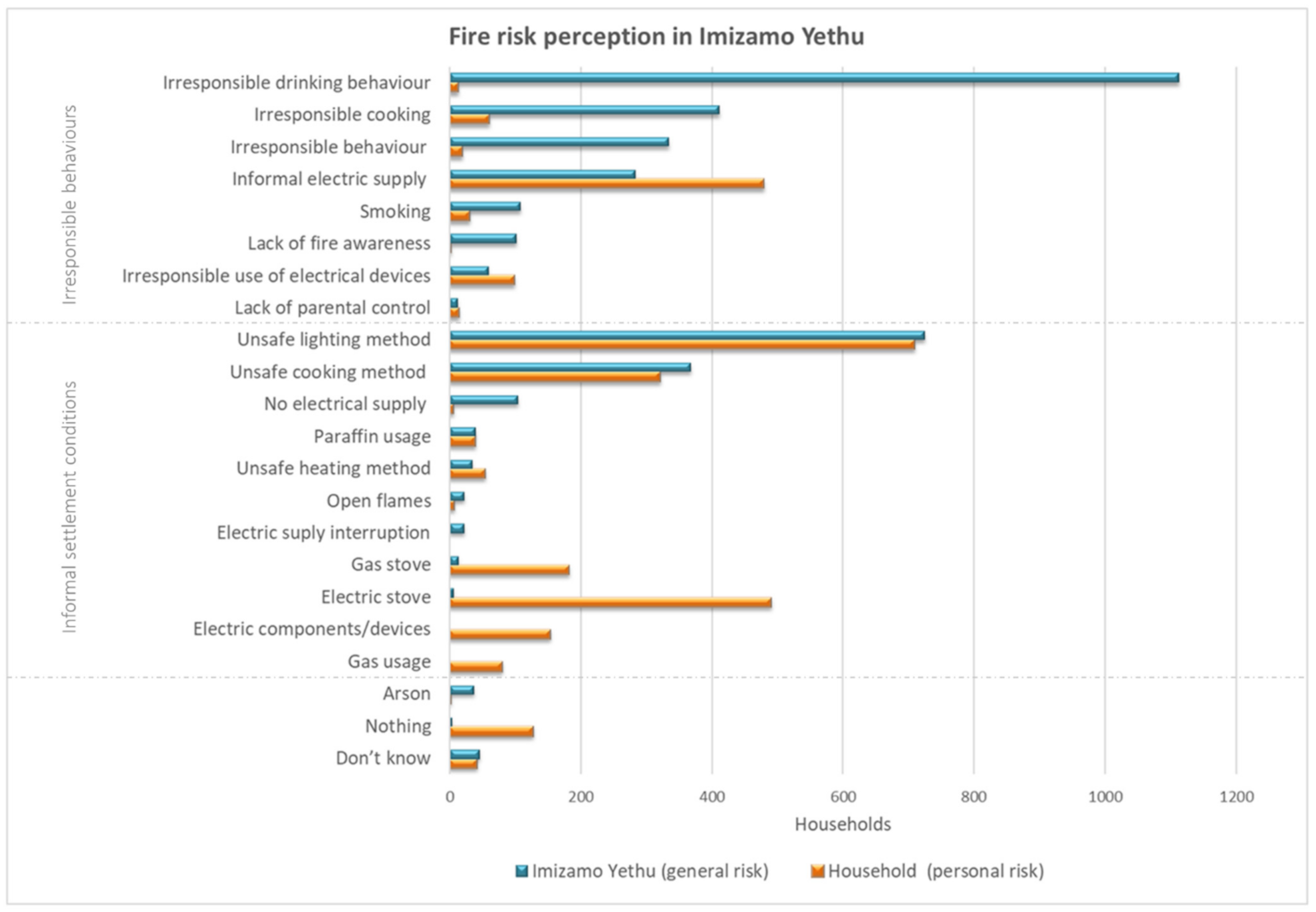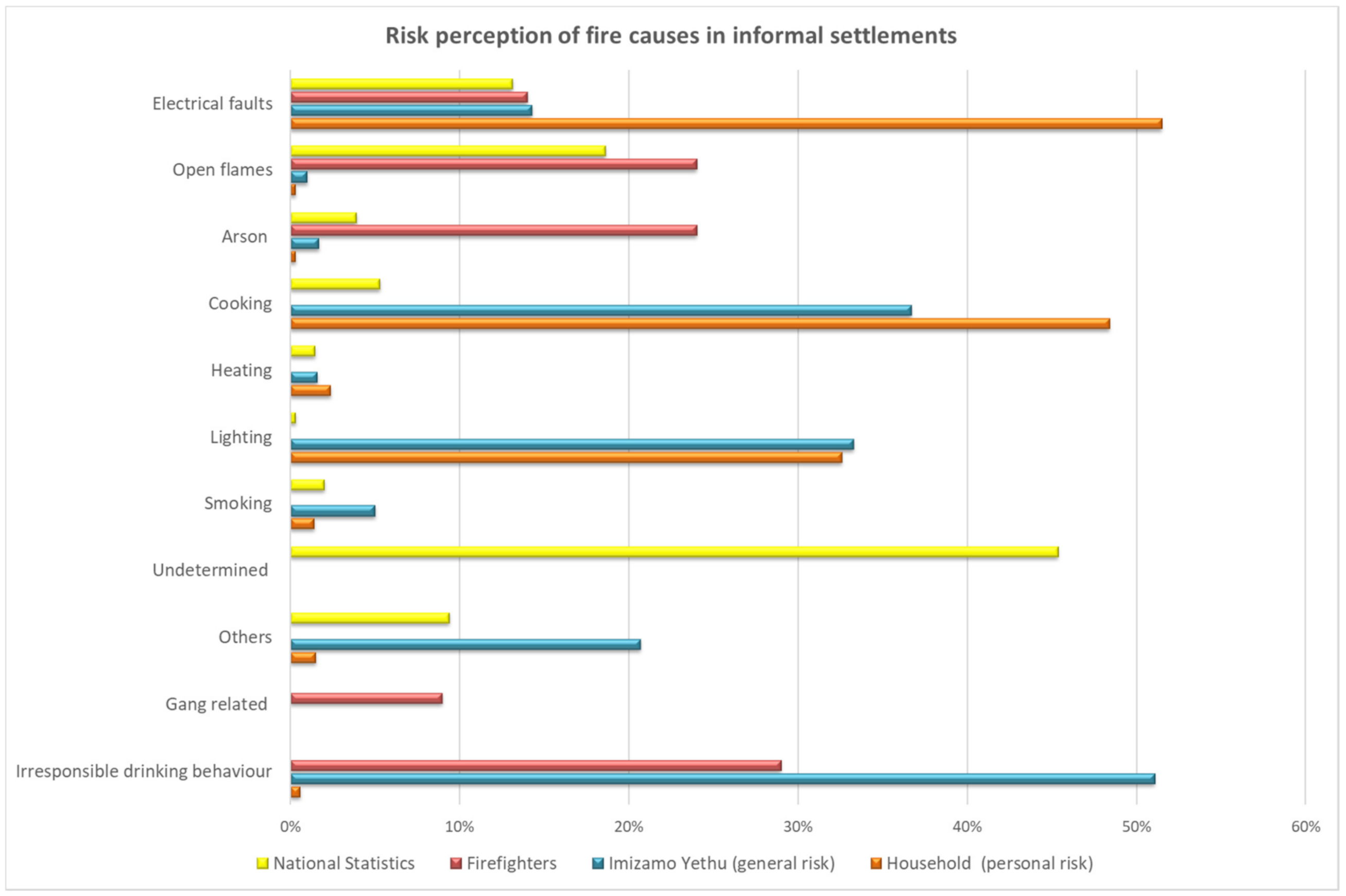Towards Understanding Fire Causes in Informal Settlements Based on Inhabitant Risk Perception
Abstract
:1. Introduction
2. Imizamo Yethu Informal Settlement
2.1. Location and Demographics
2.2. Living Conditions
2.3. Imizamo Yethu Fires
3. Survey
3.1. Survey Structure
3.2. Data Processing
3.3. How to Go from Risk Perceptions to Fire Causes?
3.4. Limitations
4. Results
4.1. Fire Risk Perception in Imizamu Yethu
4.2. Fire Risk in the Household
4.3. Measures to Reduce Fire Risk
5. Discussion
5.1. Risk Perception
5.1.1. General Risk—Inhabitants’ Risk Perception of Other Residents
5.1.2. Personal Risk—Inhabitants’ Risk Perception of Their Own Household
5.1.3. General Risk versus Personal Risk
5.1.4. Measures to Reduce Fire Risk
5.2. Fire Cause
5.2.1. Official Fire Causes versus Fire Cause Factors Observed by the Residents
5.2.2. Recommendations for Improving the National Data Collection
6. Conclusions
Author Contributions
Funding
Institutional Review Board Statement
Informed Consent Statement
Data Availability Statement
Acknowledgments
Conflicts of Interest
References
- Walls, R.; Olivier, G.; Eksteen, R. Informal settlement fires in South Africa: Fire engineering overview and full-scale tests on “shacks”. Fire Saf. J. 2017, 91, 997–1006. [Google Scholar] [CrossRef]
- Pelling, M.; Wisner, B.; Pharoah, R. Disaster Risk Reduction Cases from Urban Africa, 1st ed.; Routledge: London, UK, 2008. [Google Scholar] [CrossRef]
- Zweig, P.; Pharoah, R. Unique in their complexity: Conceptualising everyday risk in urban communities in the Western Cape, South Africa. Int. J. Disaster Risk Reduct. 2017, 26, 51–56. [Google Scholar] [CrossRef]
- FPASA. 2019 National Fire Statistics; Fire Protection Association of Southern Africa: Bryanston, South Africa, 2020. [Google Scholar]
- Flores Quiroz, N.; Walls, R.; Cicione, A. Developing a framework for fire investigations in informal settlements. Fire Saf. J. 2021, 120, 103046. [Google Scholar] [CrossRef]
- FPASA, SA National Fire Statistics 2003–2014. 2017. Available online: http://www.fpasa.co.za/journals/sa-national-fire-statistics (accessed on 9 October 2020).
- NFPA. NFPA 921-Guide for Fire and Explosion Investigations; National Fire Protection Association: Quincy, MA, USA, 2017. [Google Scholar]
- Cicione, A.; Walls, R.S.; Kahanji, C. Experimental study of fire spread between multiple full scale informal settlement dwellings. Fire Saf. J. 2019, 105, 19–27. [Google Scholar] [CrossRef]
- Sjöberg, L.; Moen, E.; Rundmo, T. Explaining Risk Perception: An Evaluation of the Psychometric Paradigm in Risk Perception Research; Norwegian University of Science and Technology, Rotunde: Trondheim, Norway, 2004. [Google Scholar]
- Watts, J.M.; Hall, J.R. Introduction to Fire Risk Analysis. In SFPE Handbook of Fire Protection Engineering; Springer: New York, NY, USA, 2016; pp. 2817–2826. [Google Scholar] [CrossRef]
- Vandeventer, A. Factors Influencing Residential Risk Perception in Fire-Prone Landscapes; Oregon State University: Corvallis, OR, USA, 2012; p. 32. [Google Scholar]
- Sjöberg, L. Factors in risk perception. Risk Anal. 2000, 20, 187–211. [Google Scholar] [CrossRef]
- Arvai, J.; Gregory, R.; Ohlson, D.; Blackwell, B.; Gray, R. Letdowns, Wake-up Calls, and Constructed Preferences: People’s Responses to Fuel and Wildfire Risks. J. For. 2006, 104, 173–181. [Google Scholar]
- Sigve, O.; Bjørg-Elin, M.; Klempe, H.; Torbjørn, R. Explaining risk perception: An empirical evaluation of cultural theory. Rotunde 2004, 85, 127. [Google Scholar] [CrossRef]
- Sjöberg, L. The Different Dynamics of Personal and General Risk. Risk Manag. 2003, 5, 19–34. [Google Scholar] [CrossRef]
- Zweig, P.; Pharoah, R.; Eksteen, R.; Walls, R. Installation of Smoke Alarms in an Informal Settlement Community in Cape Town, South Africa. Final Rep. 2018. [Google Scholar]
- McGee, T.K.; McFarlane, B.L.; Varghese, J. An examination of the influence of hazard experience on wildfire risk perceptions and adoption of mitigation measures. Soc. Nat. Resour. 2009, 22, 308–323. [Google Scholar] [CrossRef]
- Kahanji, C.; Walls, R.S.; Cicione, A. Fire spread analysis for the 2017 Imizamo Yethu informal settlement conflagration in South Africa. Int. J. Disaster Risk Reduct. 2019, 39, 101146. [Google Scholar] [CrossRef]
- CityPopulation. Imizamo Yethu. Available online: https://www.citypopulation.de/en/southafrica/cityofcapetown/199043__imizamo_yethu/ (accessed on 16 October 2020).
- Esri. Map Hout Bay Area. Available online: https://www.arcgis.com/home/webmap/viewer.html?useExisting=1&layers=10df2279f9684e4a9f6a7f08febac2a9. (accessed on 22 July 2021).
- DailyMaverick. The Smell of Fire Hangs in the Air in Imizamo Yethu, Dly. Maverick. Available online: https://www.dailymaverick.co.za/article/2020-09-10-the-smell-of-fire-hangs-in-the-air-in-imizamo-yethu/ (accessed on 15 October 2020).
- Flores Quiroz, N.; Walls, R.; Cicione, A.; Smith, M. Fire incident analysis of a large-scale informal settlement fire based on video imagery. Int. J. Disaster Risk Reduct. 2021, 55. [Google Scholar] [CrossRef]
- SundayTimes. Another Fire in Imizamo Yethu Leaves One Dead and 400 Homeless. 2017. Available online: https://www.timeslive.co.za/news/south-africa/2017-04-17-another-fire-in-imizamo-yethu-leaves-one-dead-and-400-homeless/ (accessed on 16 October 2020).
- EyewitnessNews. 60 Left Homeless Following Imizamo Yethu Fire. 2017. Available online: https://ewn.co.za/2017/08/21/60-people-left-homeless-following-imizamo-yethu-fire (accessed on 16 October 2020).
- News24. Some Residents Turn on Firefighters Battling Cape Town Blaze. 2017. Available online: https://www.news24.com/news24/southafrica/news/some-residents-turn-on-firefighters-battling-cape-town-blaze-20170829 (accessed on 16 October 2020).
- SundayTimes. Cape Town Firefighter Attacked While Battling Blaze That Has Left 350 Homeless. 2018. Available online: https://www.timeslive.co.za/news/south-africa/2018-02-12-cape-town-firefighter-attacked-while-battling-blaze-that-left-350-homeless/ (accessed on 16 October 2020).
- News24. Baby’s Tiny Body after Hout Bay Fire Was “as Small as Loaf of Bread”–Witness. 2018. Available online: https://www.news24.com/news24/southafrica/news/babys-tiny-body-after-hout-bay-fire-was-as-small-as-loaf-of-bread-witness-20180703 (accessed on 16 October 2020).
- TheCitizen. Forty Shacks Have Been Destroyed in a Fire in Gauteng, While in Cape Town a Woman Has Been Killed in Another Shack Fire. 2018. Available online: https://citizen.co.za/news/south-africa/1968651/shack-fires-devastate-cape-town-and-gauteng/ (accessed on 16 October 2020).
- IOL. Scores Displaced after Fires Gut Informal Structures in Imizamo Yethu, Du Noon. 2018. Available online: https://www.iol.co.za/capetimes/scores-displaced-after-fires-gut-informal-structures-in-imizamo-yethu-du-noon-16688146 (accessed on 16 October 2020).
- News24. Fire Hits Mandela Park in Imizamo Yethu Again. 2019. Available online: https://www.news24.com/news24/southafrica/local/peoples-post/fire-hits-mandela-park-in-imizamo-yethu-again-20190226 (accessed on 16 October 2020).
- News24. Hout Bay Blaze Extinguished, No Injuries Reported. 2019. Available online: https://www.news24.com/news24/southafrica/news/hout-bay-blaze-extinguished-no-injuries-reported-20200106 (accessed on 16 October 2020).
- News24. 200 People Left Homeless after Fire Breaks out in Hout Bay’s Mandela Park. 2020. Available online: https://www.news24.com/news24/southafrica/news/200-people-left-homeless-after-fire-breaks-out-in-hout-bays-mandela-park-20200706 (accessed on 16 October 2020).
- Cicione, A.; Beshir, M.; Walls, R.S.; Rush, D. Full-Scale Informal Settlement Dwelling Fire Experiments and Development of Numerical Models. Fire Technol. 2020, 56, 639–672. [Google Scholar] [CrossRef] [Green Version]
- Ahrens, M. Home Structure Fires; NFPA Research: Quincy, MA, USA, 2019. [Google Scholar]
- Van Niekerk, A.; Laubscher, R.; Laflamme, L. Demographic and circumstantial accounts of burn mortality in Cape Town, South Africa, 2001–2004: An observational register based study. BMC Public Health 2009, 9, 374. [Google Scholar] [CrossRef] [PubMed] [Green Version]
- Sjöberg, L. Risk perception of alcohol consumption. Alcohol. Clin. Exp. Res. 1998, 22, 277s–284s. [Google Scholar] [CrossRef]
- Sjöberg, L. Risk perception: Experts and the public. Eur. Psychol. 1998, 3, 1–12. [Google Scholar] [CrossRef]
- Arce, S.G.; Jeanneret, C.; Gales, J.; Antonellis, D.; Vaiciulyte, S. Human behaviour in informal settlement fires in Costa Rica. Saf. Sci. 2021, 142, 105384. [Google Scholar] [CrossRef]
- FEMA. National Fire Incident Reporting System; US Fire Administration National Fire Data Center: Charlotte, NC, USA, 2015.
- Walls, R.; Cicione, A.; Pharoah, R.; Zweig, P.; Smith, M.; Antonellis, D. Fire Safety Engineering Guideline for Informal Settlements: Towards Practical Solutions for a Complex Problem in South Africa; FireSUN Publications: Stellenbosch, South Africa, 2020. [Google Scholar]





| Living Conditions in IY | ||||||
|---|---|---|---|---|---|---|
| Housing Conditions | Construction materials | Corrugated iron and wood | Brick, corrugated iron and wood | |||
| 98% | 2% | |||||
| Floor Area | 1–15 m2 | 15–30 m2 | More than 30 m2 | |||
| 55% | 39% | 6% | ||||
| Proximity to adjacent dwellings | Directly attached | Less than 1 m | More than 1 m | |||
| 48% | 38% | 14% | ||||
| Basic Services | Access to running water | In the household | Within 25 m from the household | More than 25 m from the household | ||
| 24% | 60% | 16% | ||||
| Electricity | Formal | Informal | No electricity | |||
| 41% | 31% | 28% | ||||
| Sources of Energy | Cooking method * | Electric stove | Paraffin stove | Electric/Paraffin stove | Gas bottle | |
| 46% | 17% | 13% | 7% | |||
| Lighting method * | Electricity | Candles/Electricity | Candles | Paraffin lamp | ||
| 41% | 17% | 12% | 10% | |||
| Heating method * | No heating | Paraffin stove | Electricity | Coal stove | ||
| 55% | 22% | 10% | 9% | |||
| Household habits | Cooking after 22:00 h | Never | Few times a year | Few times a month | Few times a week | |
| 67% | 12% | 10% | 11% | |||
| Smokers in the household | Yes | No | ||||
| 34% | 66% | |||||
| Alcohol consumption in the household | Yes | No | ||||
| 53% | 47% | |||||
| Date | Dwellings Affected | Displaced People | Fatalities | Reference |
|---|---|---|---|---|
| 11/03/2017 | 2194 | ±9700 | 4 | [17] |
| 16/04/2017 | ±100 | ±400 | 1 | [23] |
| 20/08/2017 | 20 | ±60 | 0 | [24] |
| 27/08/2017 | 52 | ±130 | 1 | [25] |
| 12/02/2018 | 95 | ±350 | 0 | [26] |
| 01/07/2018 | +15 | No info | 2 | [27,28] |
| 21/08/2018 | No info | ±60 | 0 | [29] |
| 26/02/2019 | ±20 | +70 | 0 | [30] |
| 06/01/2020 | 7 | 30 | 0 | [31] |
| 06/07/2020 | ±50 | ±200 | 0 | [32] |
| 06/09/2020 | 263 | ±1500 | 0 | [21] |
| Question | Information | Question | Information |
|---|---|---|---|
| Q1 | Family size | Q13 | Electricity |
| Q2 | Gender and Age | Q14 | Cooking method |
| Q3 | Highest education level in the household | Q15 | Lighting method |
| Q4 | Nationality | Q16 | Heating method |
| Q5 | Number of Disabled people(s) in household | Q17 | How often does it happen that someone cooks late at night (after 10?) |
| Q6 | What do you consider to be the greatest fire risk in IY? | Q18 | Is there anyone in the house who drinks? |
| Q7 | What do you consider to be the greatest fire risk in your household? | Q19 | Are there any smokers in the house? |
| Q8 | What are the things you would like to do to reduce fire risk? | Q20 | Has your household experienced a fire before? |
| Q9 | Type of housing structure | Q21 | Fire detector? |
| Q10 | Size (floor area) of house | Q22 | Fire blanket or bucket of sand/water? |
| Q11 | Proximity to the neighbouring house | Q23 | Fire extinguisher? |
| Q12 | Proximity to running water | Q24 | Fire retardant paint on walls? |
| Category | Includes | Category | Includes |
|---|---|---|---|
| Arson |
| Irresponsible drinking behaviour |
|
| Poor accessibility |
| Irresponsible behaviour |
|
| No response—Does not know | |||
| Electrical components |
| Irresponsible use of electrical devices |
|
| Electric stove | |||
| Electric supply interruption |
| Lack of fire awareness |
|
| Gas stove | Lack of parental control |
| |
| Gas/Gas heater/Gas bottle | |||
| Houses closely built next to each other | No electrical supply | ||
| Informal electric supply |
| Nothing | |
| Open flames * | |||
| Overcrowded | |||
| Smoking | |||
| Informal houses | Unsafe cooking methods | Open flames *, paraffin stove | |
| Irresponsible cooking |
| Unsafe heating methods | Open flames *, paraffin, coal |
| Unsafe lighting methods | Candle, paraffin lamp |
| Category | Includes | Category | Includes |
|---|---|---|---|
| Being Responsible | Proper houses |
| |
| Better access |
| Remove flammable items | |
| No response—Does not know | Safer cooking methods | ||
| Education |
| Safer lighting | |
| Solar panel | |||
| Fire detector | More space between houses | ||
| Fire protection devices |
| Super blocking | |
| Responsible cooking | |||
| Fire retardant paint | Responsible drinking/Reduce alcohol consumption |
| |
| Formal Electricity | |||
| Improve firefighters’ operations |
| Responsible use of electrical appliances/Safe appliances |
|
| Nothing | Water supply |
| |
| Parental control | |||
| Official Fire Cause | Fire Cause Observed by the Residents | |
|---|---|---|
| Smoking | Smoking | |
| Electrical fault | Informal electrical supply | |
| Electric components | ||
| Irresponsible use of electrical devices | ||
| Electrical supply interruption | ||
| Open flames * | Open flames * | |
| Cooking * | ||
| Heating * | ||
| Cooking * | Irresponsible cooking | Gas Gas bottle No electrical supply Paraffin Open flames * |
| Unsafe cooking method | ||
| Gas stove | ||
| Electric stove | ||
| Heating * | Unsafe heating method | |
| Lighting * | Unsafe lighting method | |
| Suspected arson | Arson | |
| Undetermined | ||
| Others ** | Irresponsible drinking behaviour | |
| Irresponsible behaviour | ||
| Lack of fire awareness | ||
| Lack parental control | ||
| Fire Risk in Imizamo Yethu | Percentage [%] | Fire Risk in Imizamo Yethu | Percentage [%] |
|---|---|---|---|
| Irresponsible drinking behaviour | 51.1 | Paraffin | 1.8 |
| Unsafe lighting method | 33.3 | Arson | 1.7 |
| Irresponsible cooking | 18.9 | Unsafe heating method | 1.6 |
| Unsafe cooking method | 16.9 | Informal houses | 1.5 |
| Irresponsible behaviour | 15.4 | Overcrowded | 1.3 |
| Informal electric supply | 13.0 | Open flames | 1.0 |
| Houses closely built next to each other | 7.1 | Electric supply interruption | 1.0 |
| Smoking | 5.0 | Gas stove | 0.6 |
| No electrical supply | 4.8 | Lack of parental control | 0.6 |
| Lack of fire awareness | 4.7 | Poor access | 0.3 |
| Irresponsible use electrical devices | 2.7 | Electric stove | 0.3 |
| No response—Does not know | 2.1 | Nothing | 0.2 |
| Fire Risk in Your Household | Percentage [%] | Fire Risk in Your Household | Percentage [%] |
|---|---|---|---|
| Unsafe lighting method | 32.6 | No response—Does not know | 1.9 |
| Electric stove | 22.5 | Paraffin | 1.8 |
| Informal electric supply | 22.0 | Smoking | 1.4 |
| Unsafe cooking method | 14.7 | Irresponsible behaviour | 0.9 |
| Gas stove | 8.4 | Lack parental control | 0.6 |
| Electric components | 7.0 | Houses closely built next to each other | 0.6 |
| Nothing | 5.8 | Irresponsible drinking behaviour | 0.6 |
| Irresponsible use of electrical devices | 4.5 | Informal houses | 0.5 |
| Gas/Gas heater/Gas bottle | 3.7 | Open flames | 0.3 |
| Irresponsible cooking | 2.8 | No electrical supply | 0.2 |
| Unsafe heating method | 2.4 | Overcrowded | 0.1 |
| Measures to Reduce Fire Risk | Percentage [%] | Fire Risk in Your Household | Percentage [%] |
|---|---|---|---|
| Formal Electricity | 33.9 | Water supply | 3.1 |
| Proper house | 25.8 | Fire protection devices | 3 |
| Spaces between houses | 18.2 | Nothing | 2.9 |
| Educate | 9.6 | Being Responsible | 2.8 |
| Better Access | 6.8 | Safer cooking methods | 2.2 |
| Irresponsible use of electrical appliances/Safe appliances | 5 | Solar panel | 1.3 |
| No response—Does not know | 4.7 | Fire detector | 1.1 |
| Super blocking | 4 | Remove flammable items | 0.9 |
| Responsible cooking | 3.9 | Parental control | 0.6 |
| Responsible drinking/Reduce alcohol consumption | 3.6 | Improve firefighters’ operations | 0.6 |
| Safer lighting | 3.3 | Fire retardant paint | 0.5 |
| Official Fire Cause | Details | Additional Info (Not Documented) |
|---|---|---|
| Electrical Fault | Suspected power surge of electrical current to faulty plug socket. | Informal electrical supply. |
| Cooking | Stove overturning and igniting bed, bedding, etc. | Witnesses indicate the man was under alcohol influence He was cooking on a paraffin stove. |
| Factor | Details | Factor | Details |
|---|---|---|---|
| Ignition | Area of fire origin Heat source Item first ignited Type of material first ignited | Human factors contributing to ignition | Asleep Possibly impaired by alcohol or drugs Unattended person Physically disabled Multiple persons involved |
| Cause of ignition | Intentional Unintentional Failure of equipment or heat source Act of nature Cause under investigation Cause undetermined after investigation | Equipment involved in ignition | Brand, Model, Serial #, Year |
| Equipment power source | i.e., Electrical, Gas fuels, liquid fuels, solid fuels |
Publisher’s Note: MDPI stays neutral with regard to jurisdictional claims in published maps and institutional affiliations. |
© 2021 by the authors. Licensee MDPI, Basel, Switzerland. This article is an open access article distributed under the terms and conditions of the Creative Commons Attribution (CC BY) license (https://creativecommons.org/licenses/by/4.0/).
Share and Cite
Flores Quiroz, N.; Walls, R.; Cicione, A. Towards Understanding Fire Causes in Informal Settlements Based on Inhabitant Risk Perception. Fire 2021, 4, 39. https://0-doi-org.brum.beds.ac.uk/10.3390/fire4030039
Flores Quiroz N, Walls R, Cicione A. Towards Understanding Fire Causes in Informal Settlements Based on Inhabitant Risk Perception. Fire. 2021; 4(3):39. https://0-doi-org.brum.beds.ac.uk/10.3390/fire4030039
Chicago/Turabian StyleFlores Quiroz, Natalia, Richard Walls, and Antonio Cicione. 2021. "Towards Understanding Fire Causes in Informal Settlements Based on Inhabitant Risk Perception" Fire 4, no. 3: 39. https://0-doi-org.brum.beds.ac.uk/10.3390/fire4030039







